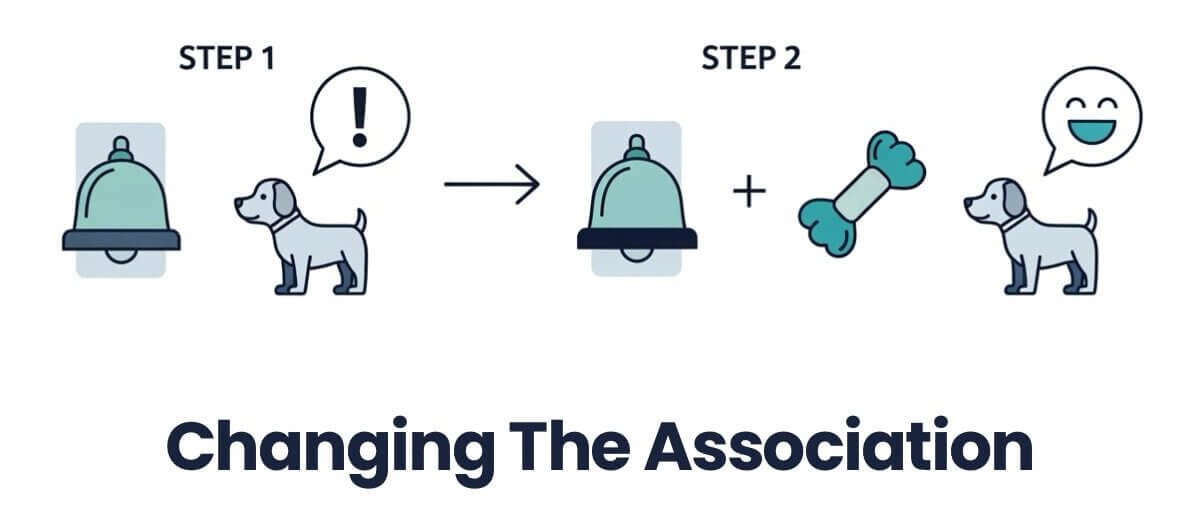If you’re searching for the best dog bark collar, I know you’re likely at your wit’s end. You love your dog, but the constant barking is causing stress for you, your family, and maybe even your neighbors. You’re looking for a solution that works, and you need it now.
Before you click ‘buy,’ let me walk you through what modern, certified trainers recommend instead. As a professional, my goal is to solve the reason for the barking, not just suppress the sound. There are kinder, more effective ways to achieve a peaceful home that will strengthen your bond with your dog, rather than relying on punishment.
Smarter Paws Academy is reader-supported. When you buy through links on our site, we may earn an affiliate commission at no extra cost to you. As an Amazon Associate, I earn from qualifying purchases. Thank you for your support!
Important Behavior Disclaimer
This guide is for common nuisance barking. If your dog’s barking is accompanied by aggression, extreme fear, or other serious behaviors, please consult a qualified veterinary behaviorist or a certified professional dog trainer.
Quick Guide: Bark Collars vs. Humane Alternatives
- Experts Advise Against Them: Major veterinary and training organizations recommend against punishment-based collars due to risks of increased fear, anxiety, and aggression.
- Address the Root Cause: Barking is a symptom. The real solution is to identify and solve the underlying cause, whether it’s boredom, anxiety, or territorial instincts.
- Positive Alternatives Work Better: Tools that provide enrichment, calming, and management are kinder and more effective for long-term results.
Prefer to Listen? An Audio Overview
For a conversational deep dive into this topic, press play below for the complete audio discussion.
Runtime: 1 minute 45 seconds
View Full Audio Transcript
Narrator: Welcome to the Smarter Paws Academy audio overview. Today, Sandie is tackling a controversial topic: bark collars. Sandie, what’s your professional stance as a certified trainer?
Sandie Calloway: Thanks for having me. My stance, which is backed by major veterinary organizations, is that we should avoid punishment-based tools like bark collars. They’re designed to stop a symptom—the noise—but they do nothing to solve the real problem, which is the underlying reason the dog is barking in the first place.
Narrator: So what are the risks of using one?
Sandie Calloway: The biggest risk is fallout. A dog punished by a collar might stop barking, but the anxiety or fear causing the bark is still there, and it can come out in other ways, like aggression or destructive behavior. You can also damage the trust you have with your dog.
Narrator: So what’s a better, more humane alternative for a dog that barks from boredom?
Sandie Calloway: The best alternative is enrichment. Instead of punishing the dog for being bored, we give them a productive “job” to do. A puzzle toy, for example, engages their brain and tires them out in a positive way. A mentally tired dog is a quiet dog.
Narrator: And for a dog that barks from anxiety?
Sandie Calloway: For anxiety, the solution is to create a sense of calm. You can’t punish fear away. Tools like calming supplements or a ThunderShirt apply gentle, constant pressure that soothes the dog’s nervous system. It’s a compassionate approach that addresses the root emotion.
Narrator: So the core philosophy is to be a detective, not a disciplinarian.
Sandie Calloway: Exactly. Understand why your dog is barking, and then provide a positive solution for that specific need. That’s how you get a quieter home and a stronger, more trusting relationship with your dog.
Table of Contents
Why Do Dogs Bark Excessively? Understanding the Root Cause
A bark collar is a tool designed to stop a symptom, but it does nothing to address the actual illness. To find a real solution, we first have to understand why our dogs are barking. The most common reasons for excessive barking are:
- Boredom & Frustration: A dog without enough mental or physical exercise will invent their own job, and that job is often barking.
- Anxiety & Fear: Barking is a common response to scary things like thunderstorms, fireworks, or being left alone (a major cause of puppy barking in the crate).
- Territorial & Alarm Barking: This is the classic “watchdog” bark in response to people, animals, or vehicles passing by your home. This is a common reason for dogs barking at people on walks.
- Attention-Seeking: Some dogs learn that barking is a very effective way to get their owner’s attention.
Do Vets Recommend Bark Collars for Dogs?
No, the majority of modern veterinarians, veterinary behaviorists, and certified trainers advise against the use of punishment-based bark collars. In fact, leading professional organizations like the Pet Professional Guild (PPG) have published strong position statements detailing the risks. Their research highlights that these tools can cause significant physical and psychological harm.
The key risks of using aversive collars include:
- Increased Fear and Anxiety: Punishing a fear-based behavior (like barking at strangers) can make the dog even more fearful.
- Negative Associations (Fallout): A dog might associate the punishment not with their bark, but with the person or dog they were barking at, leading to aggression.
- Damaged Human-Animal Bond: Using punishment can erode the trust and positive relationship you have with your dog.
Shock vs. Vibration vs. Spray: What’s the Difference?
Many owners ask if a vibration collar is better than a shock collar. While the methods differ, the underlying principle is the same: they are all forms of punishment designed to stop a behavior by delivering an unpleasant sensation.
- Shock Collars: Deliver a static electric shock.
- Vibration Collars: Deliver a strong vibration, which is still an unpleasant interruption (an aversive).
- Citronella/Spray Collars: Punish the dog with an unpleasant scent or spray to the face.
While some are harsher than others, none of them teach your dog what you want them to do instead. They only say “No,” without providing a “Yes.”
The Real Solution: Counter-Conditioning and Positive Training
The most effective and humane way to change barking behavior is to change the underlying emotion that causes it. The science-backed process for this is called Counter-Conditioning and Desensitization (CC&D). As the Animal Humane Society explains, this process involves changing your dog’s association with a trigger from negative to positive.
Here’s a simple example for a dog that barks at the doorbell:

- Start with the trigger at a very low intensity (e.g., play a recording of a doorbell very quietly).
- The instant your dog hears the quiet sound but before they bark, give them an extremely high-value treat.
- Repeat this process many times, gradually increasing the volume of the doorbell sound over many sessions.
Over time, your dog’s emotional response changes. The doorbell sound no longer means “Intruder!”—it now means “Amazing treat is coming!” This is how you solve the root problem.
4 Humane Alternatives to a Bark Collar
Instead of punishing the bark, let’s use tools that help with management and positive training.
1. The Alternative to Punishing Boredom: Enrichment Puzzles
If your dog barks from boredom, the solution is to make their life more interesting. An enrichment puzzle gives them a mentally stimulating “job” to do, satisfying their natural instincts and tiring them out in a positive way.
Why this works: This puzzle provides the mental stimulation that a bored, barking dog craves. It turns their energy towards a productive “job” of sniffing and problem-solving, which is a powerful, positive way to reduce frustration-based barking.
2. The Alternative to Punishing Anxiety: Calming Chews
For dogs whose barking is rooted in anxiety, punishing them is unkind and ineffective. A better approach is to help lower their overall stress level. Calming supplements use natural ingredients to help a dog feel more relaxed and less likely to react to triggers.
Why this is a kinder approach: For a dog who barks from fear, this supplement helps to lower their baseline anxiety. It uses natural ingredients like L-Theanine to promote relaxation, addressing the root emotional cause of the barking rather than punishing the symptom.
3. The Alternative to Punishing a Lack of Communication: A Clicker
A bark collar is a one-way communication tool: it only says No. A clicker is a two-way communication tool. It allows you to precisely mark the moment your dog is quiet and then follow it with a reward. This is how you clearly and kindly teach your dog the behavior you want to see.
Why this is a better tool: A bark collar only says “No.” A clicker allows you to say “Yes!” at the exact moment your dog is quiet. It’s a precise, powerful tool for clearly communicating the behavior you want to see, building a language of positive reinforcement.
4. The Humane Alternative for Temporary Management: A Basket Muzzle
In some situations, you may need to prevent barking for a short period for safety or management (like a landlord visit). A basket muzzle, when introduced positively, is a humane tool for this. It physically prevents the bark without causing pain or fear. As the Ontario SPCA explains, making the muzzle a positive experience with treats is key. It is a temporary management tool, not a training solution or a punishment.
Why this is a safe management tool: When you need to prevent barking temporarily, a basket muzzle is the most humane physical tool. It allows the dog to pant, drink, and take treats, but prevents the full bark. It must be conditioned positively as a safety tool, not a punishment.
Frequently Asked Questions
Do vibration collars stop barking?
They can interrupt a bark, but they are still a form of punishment (a positive punisher, in technical terms). They don’t solve the underlying reason for the barking and can increase a dog’s stress and anxiety, which can lead to other behavior problems.
Why is my dog still barking with a bark collar?
This is a common problem. It usually means the dog’s motivation to bark (due to intense fear, boredom, or territorial instinct) is stronger than their desire to avoid the punishment. In some cases, the punishment itself can increase their anxiety, leading to more frantic barking.
What is the 3 bark rule?
The “3 Bark Rule” is a positive training technique where you allow your dog two or three barks to alert you, then you say, “Thank you, I see it!” to acknowledge them. You then cue an alternative behavior, like “Quiet” or “Go to your mat,” and reward them for complying. It’s a way of working with your dog’s instinct to alert you.
What is the fastest way to stop a dog from barking?
The fastest management tool is to remove the trigger (e.g., use window film to block the view of the street). The fastest long-term training solution is to use positive reinforcement to teach your dog a desirable alternative behavior when their trigger appears.
What do vets recommend to stop dogs from barking?
Most modern vets will recommend a behavior-based approach. This involves identifying the cause of the barking (boredom, anxiety, etc.), managing the environment to prevent the behavior, and using enrichment and positive reinforcement training to teach the dog better coping skills and alternative behaviors.
Building a Quieter Home Through a Stronger Bond
Remember, excessive barking is your dog’s way of communicating a need. By addressing that need with patience, understanding, and positive reinforcement, you’ll not only solve the barking problem but also build a stronger, more trusting relationship with your dog. Your peaceful home is possible without ever needing to reach for a shock collar.







